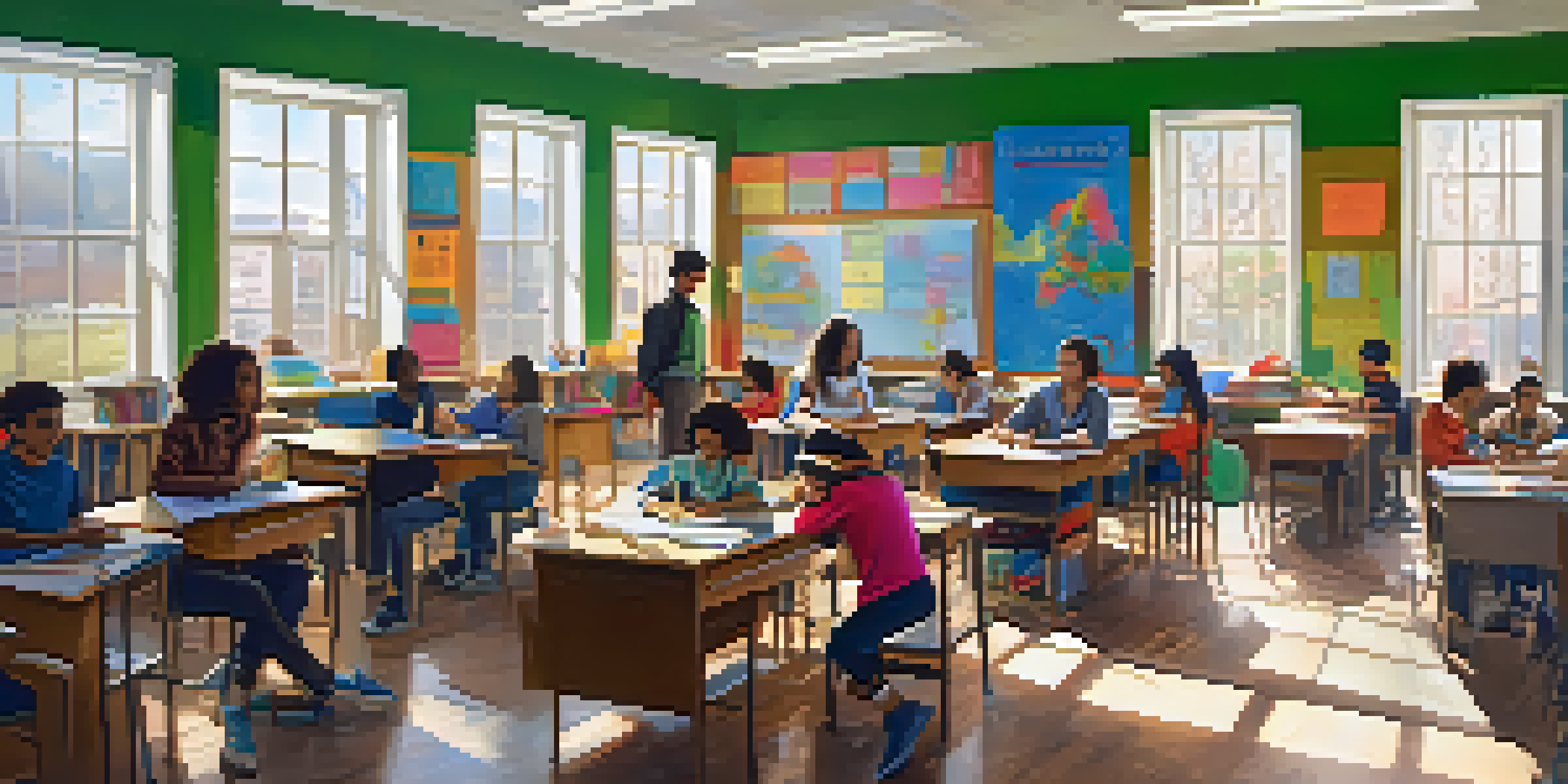Cognitive Behavioral Techniques for Classroom Management

Understanding Cognitive Behavioral Techniques in Education
Cognitive Behavioral Techniques (CBT) focus on the connection between thoughts, feelings, and behaviors. In the classroom, these techniques can help teachers address student behavior by changing negative thought patterns. By understanding how students think, educators can foster a more positive learning environment.
Change your thoughts and you change your world.
For example, if a student believes they will fail a test, this thought might lead to anxiety and disengagement. CBT encourages teachers to help students challenge these negative beliefs, replacing them with more constructive thoughts. This shift can significantly improve not only behavior but also academic performance.
Implementing CBT in the classroom is about teaching students to recognize and reframe their thoughts. When students learn to identify their cognitive distortions, they become more empowered in managing their own behaviors and emotions, leading to a more harmonious classroom atmosphere.
Establishing Clear Expectations and Rules
One of the foundational elements of effective classroom management is setting clear expectations. When students understand what is expected of them, they are more likely to meet those expectations. This clarity can be facilitated using cognitive behavioral principles to reinforce positive behavior.

For instance, teachers can create a list of classroom rules that are framed positively, such as 'Respect others' instead of 'Don't be rude.' This approach encourages students to focus on what they should do rather than what they shouldn't. By consistently reinforcing these rules, teachers can create a predictable learning environment.
Cognitive Techniques Enhance Learning
Cognitive Behavioral Techniques empower students to challenge negative thoughts, improving their behavior and academic performance.
Additionally, involving students in the rule-making process can improve their commitment to these expectations. When students feel a sense of ownership and responsibility, they are more likely to adhere to the established guidelines, fostering a cooperative classroom community.
Using Positive Reinforcement to Encourage Good Behavior
Positive reinforcement is a powerful tool in classroom management, and it aligns well with cognitive behavioral techniques. By rewarding desirable behaviors, teachers can encourage students to repeat those behaviors. This might include verbal praise, stickers, or extra recess time as incentives.
The only way to make sense out of change is to plunge into it, move with it, and join the dance.
For example, when a student raises their hand to speak instead of shouting out, a teacher can acknowledge this behavior with praise. Over time, this reinforcement can help students internalize the desired behavior, making it more likely to occur in the future. The key is to ensure that the rewards are meaningful to the students.
It's important to note that positive reinforcement should be used consistently and fairly. By establishing a system where good behavior is recognized, teachers create an environment where students feel valued and motivated to engage positively, enhancing overall classroom dynamics.
Implementing Cognitive Restructuring Techniques
Cognitive restructuring is a core aspect of CBT that can be particularly effective for classroom management. This technique involves helping students identify and change negative thought patterns that contribute to disruptive behaviors. By teaching students to challenge their thoughts, teachers can facilitate a shift toward more positive behaviors.
For instance, if a student believes they are 'bad at math,' they may avoid participating in class. By guiding them to reframe this belief—perhaps by acknowledging that everyone has strengths and weaknesses—teachers can help reduce anxiety and encourage participation. This process fosters a growth mindset, where students view challenges as opportunities for learning.
Clear Rules Foster Student Engagement
Establishing clear, positively framed expectations encourages students to take ownership of their behavior and promotes a cooperative classroom environment.
Teachers can incorporate cognitive restructuring into daily routines by having students reflect on their thoughts and feelings. Journaling or group discussions can provide a safe space for students to express and reframe their thoughts, leading to improved self-awareness and better classroom behavior.
Teaching Problem-Solving Skills to Students
Teaching problem-solving skills is essential for helping students navigate challenges both academically and socially. These skills empower students to manage conflicts and make positive choices, reducing the need for disciplinary actions. By incorporating problem-solving techniques into lessons, teachers can enhance their classroom management strategies.
For example, when conflicts arise between students, a teacher can facilitate a problem-solving discussion. This process encourages students to express their feelings, understand different perspectives, and collaboratively find a solution. Such skills not only improve individual behavior but also cultivate a sense of community within the classroom.
Moreover, problem-solving skills can be integrated into everyday classroom activities. Whether through group projects or class discussions, providing opportunities for students to practice these skills helps them become more adept at managing their emotions and behaviors, leading to a more cohesive learning environment.
Creating a Supportive Classroom Environment
A supportive classroom environment is vital for effective classroom management and student success. This environment should promote respect, inclusion, and emotional safety, allowing students to feel comfortable expressing themselves. Cognitive behavioral techniques can help create this supportive atmosphere by fostering positive relationships between teachers and students.
For instance, incorporating regular check-ins or 'feelings circles' can encourage students to share their emotions and experiences. This practice helps build trust and openness, allowing students to feel heard and understood. When students feel valued, they are more likely to engage positively in their learning.
Mindfulness Boosts Self-Regulation
Incorporating mindfulness practices helps students develop awareness and control over their emotions, leading to a calmer and more focused classroom atmosphere.
Additionally, a supportive environment includes recognizing and celebrating diversity within the classroom. By embracing different backgrounds and perspectives, teachers can cultivate an inclusive atmosphere that promotes empathy and understanding, further enhancing classroom management.
Incorporating Mindfulness and Self-Regulation Techniques
Mindfulness and self-regulation techniques are increasingly recognized as effective strategies for classroom management. These practices help students develop awareness of their thoughts and emotions, leading to improved self-control. By incorporating mindfulness activities into the daily routine, teachers can create a calmer, more focused classroom environment.
For example, short mindfulness exercises such as deep breathing or guided imagery can help students center themselves before a lesson. These techniques can reduce anxiety and enhance concentration, making students more receptive to learning. Over time, regular mindfulness practice can lead to greater emotional resilience and improved behavior.

Furthermore, teaching self-regulation skills equips students to manage their impulses and reactions. When students learn to pause and reflect before responding, they are less likely to engage in disruptive behaviors. This not only benefits individual students but contributes to a more respectful and productive classroom atmosphere.